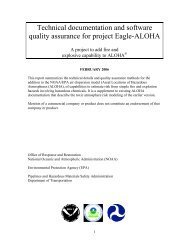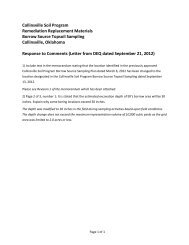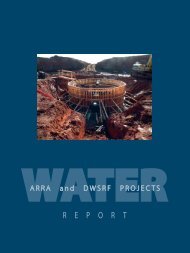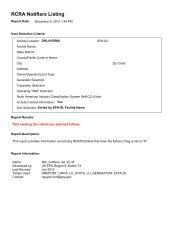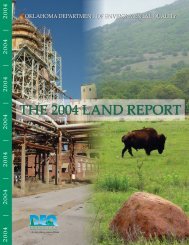Oklahoma Gas & Electric Muskogee Generating Station Best ...
Oklahoma Gas & Electric Muskogee Generating Station Best ...
Oklahoma Gas & Electric Muskogee Generating Station Best ...
You also want an ePaper? Increase the reach of your titles
YUMPU automatically turns print PDFs into web optimized ePapers that Google loves.
<strong>Oklahoma</strong> <strong>Gas</strong> & <strong>Electric</strong><br />
<strong>Muskogee</strong> <strong>Generating</strong> <strong>Station</strong> – BART Determination<br />
May 28, 2008<br />
typically contain pyrites and other dense inorganic impurities including silica and trace<br />
metals. The solids are typically dewatered in a mechanical dewatering device and disposed<br />
of in a landfill.<br />
The wastewater stream generally consists of an acidic liquid slurry made up of water,<br />
uncombusted coal fines, and impurities in the coal, including calcium, trace metals,<br />
chloride, sulfate, and dissolved and suspended solids. 17 The wastewater slurry must be<br />
treated to remove solids, coal fines, and trace metals prior to discharge. Coal slurry<br />
treatment systems may include surface impoundments, mechanical dewatering systems,<br />
chemical processing systems, and/or thermal dryers.<br />
While washing may be effective in removing rock inclusions from coal, including sulfurbearing<br />
pyrites, a significant amount of coal may also be lost in the washing process. An<br />
inherent consequence of coal washing, in addition to generating wastewater and solid waste<br />
streams, would be the need for the mine to process significantly more coal to make up for<br />
coal lost in the washing process.<br />
<strong>Muskogee</strong> Units 4 & 5 are designed to utilize subbituminous coals. Based on a review of<br />
available information, no information was identified regarding the washability or<br />
effectiveness of washing subbituminous coals. Subbituminous coals have a relatively high<br />
ash content and an excessive amount of fines, and significant dewatering equipment would<br />
be required to process and separate the fines from the wastewater stream. It is likely that<br />
the excess fines production, and the difficulties associated with handling and dewatering<br />
the fines, have restricted the commercial viability of subbituminous coal washing.<br />
Furthermore, the coal washing process would generate significant solid and liquid waste<br />
streams that would require proper management and disposal. Based on a review of<br />
available information, there are currently no commercial subbituminous coal washing<br />
facilities, and washed subbituminous coals are not available through commercial channels.<br />
Therefore, coal washing is not considered an available retrofit control option for <strong>Muskogee</strong><br />
Units 4 & 5.<br />
4.2.1.3 Coal Processing<br />
Pre-combustion coal processing techniques have been proposed as one strategy to reduce<br />
the sulfur content of coal and help reduce uncontrolled SO2 emissions. Coal processing<br />
17 See, USEPA Report to Congress, Wastes from the Combustion of Fossil Fuels, Office of Solid Waste and<br />
Emergency Response, EPA 530-S-99-010, March 1999 (general composition of selected large-volume and<br />
low-volume wastes).<br />
35



